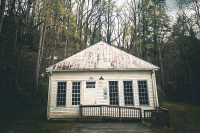The Naturalist's Corner
Taking a swim through the air
On long narrow graceful wings, the common nighthawk seems lighter than air as it dips, glides, banks and dives to scoop flying insects out of the sky. As common as dusk itself, this aerobatic ballet was performed all summer long across the ball fields, hay fields, cotton fields, marshes and farm ponds of my youth.
Etched as it is in my psyche, this vision is largely a memory. But for the next couple of weeks I will spend the occasionally evening out and about scouring the horizon for an encore performance.
Autumn migration is the most reliable time to see common nighthawks across Western North Carolina and recent posts on the Carolina Bird Club’s listserv from Galax, Va., through Raleigh to Long Shoals Road south of Asheville attest to the fact that migration is upon us.
With a wingspan of two feet, these crepuscular fliers look to be all wings and head as the slim nine-inch body tapers away to air. Common nighthawks belong to the family Caprimulgidae, which loosely translated from the Greek means “goat-sucker.” Fable has it that shepherds and farmers from the days of Aristotle feared these large-mouthed birds often found in the fields at dawn were suckling from the goats and sheep at night. The family is also known collectively as “nightjars” because of the loud nighttime and predawn calls of some species like the European nightjar, whip-poor-will and Chuck-will’s-widow. Where I grew up they were known as bullbats, probably because of their bat-like insect-chasing aerobatics and the loud booming noise the male makes with its wings during courtship displays.
Because of the widespread distribution of this species — it nests across North America including some areas of Mexico and winters from Central to South America — and the fact that it is abundant in some areas, it is listed as a species of “least concern” by the IUCN (International Union for the Conservation of Nature.)
Related Items
But by the time I left Louisiana in the mid-1980s the numbers of common nighthawk appeared to be dwindling, especially in northeast Louisiana. And it seems the same is true across its range.
There have been efforts to get citizens involved in surveying, a la “hawk watches,” as common nighthawks do migrate in loose flocks and can often be seen at twilight. I have run across some local watches like Haverford College in Pennsylvania and one in Charlottesville, Va., sponsored by the Monticello Bird Club, but I know of none in the region.
But official or not, getting out on these autumn evenings at dusk, especially in open, rural areas is a treat in itself. So if you need an excuse — go on a nighthawk watch. Just don’t be surprised, should you encounter some, to find yourself back again next autumn to watch this life-affirming ballet and marvel at how our North Carolina mosquitoes help fuel that Canadian-breeding air-dancer to its winter home in Brazil.













